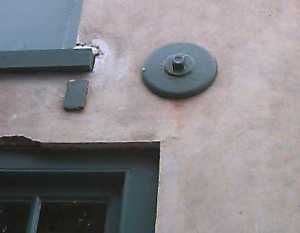Earthquake Bolts:
On August 31, 1886, Charleston was struck by one of the largest earthquakes ever recorded on the East Coast. Its epicenter was in Summerville, some 25 miles northwest of the city, and shocks were felt as far away as Canada. Hundreds of buildings in and around the city were badly damaged or destroyed. Buildings that could be salvaged were repaired or rebuilt, using long iron rods for reinforcement.The iron rods were run through walls and anchored with a washer-type device, known as a gib plate, and a large iron nut. These can still be seen on many Charleston buildings and are called “earthquake bolts.” Though earthquake bolts were made in a variety of shapes, they were fairly plain. Some building owners chose to disguise them with cast iron decorations, such as lions’ heads, or stucco. The effectiveness of earthquake bolts has never been conclusively determined. They may have been a brilliant scheme which has kept many important buildings in Charleston standing since 1886, or, as one local skeptic has suggested, they may have been a brilliant scam by an enterprising earthquake bolt salesman. Scam or scheme, their effectiveness during another big quake is very much open to question. Photos linked below illustrate various types of earthquake bolts around the city. [From Charleston’s Public Library Site].
Cuban Revolutionary [the late-nineteenth-century revolution…] and canonical author José Martí wrote a piece just after the 1886 earthquake in Charleston that you can read here [if you read Spanish].



These bolts are all over Seattle as well–I’d never heard the story about the scamming salesman before–love that! Thanks for posting.